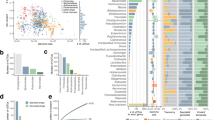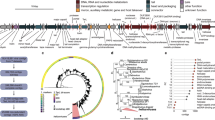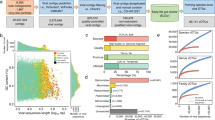Abstract
Distinct gut microbiome ecology may be implicated in the prevention of aging-related diseases as it influences systemic immune function and resistance to infections. Yet, the viral component of the microbiome throughout different stages in life remains unexplored. Here we present a characterization of the centenarian gut virome using previously published metagenomes from 195 individuals from Japan and Sardinia. Compared with gut viromes of younger adults (>18 yr) and older individuals (>60 yr), centenarians had a more diverse virome including previously undescribed viral genera, such as viruses associated with Clostridia. A population shift towards higher lytic activity was also observed. Finally, we investigated phage-encoded auxiliary functions that influence bacterial physiology, which revealed an enrichment of genes supporting key steps in sulfate metabolic pathways. Phage and bacterial members of the centenarian microbiome displayed an increased potential for converting methionine to homocysteine, sulfate to sulfide and taurine to sulfide. A greater metabolic output of microbial hydrogen sulfide in centenarians may in turn support mucosal integrity and resistance to pathobionts.
This is a preview of subscription content, access via your institution
Access options
Access Nature and 54 other Nature Portfolio journals
Get Nature+, our best-value online-access subscription
$29.99 / 30 days
cancel any time
Subscribe to this journal
Receive 12 digital issues and online access to articles
$119.00 per year
only $9.92 per issue
Buy this article
- Purchase on SpringerLink
- Instant access to full article PDF
Prices may be subject to local taxes which are calculated during checkout






Similar content being viewed by others
Data availability
This paper analyses existing, publicly available data. The raw sequencing files used in this study for Centenarian, Sardinian, Tanzanian 300FG and EDIA microbiome datasets are available at the NCBI database under accession numbers PRJNA675598, PRJEB25514, PRJNA686265 and PRJNA707065, respectively. The viral genomes used to establish previously undescribed viral biodiversity are available from the Metagenomic Viruses Database (https://portal.nersc.gov/MGV). Additional files including vOTU genomes, phylogenetic tree, VOG marker table and master annotation table for vOTUs can be accessed at Zenodo (https://doi.org/10.5281/zenodo.6579480). Source data are provided in Supplementary Information.
Code availability
All original code has been deposited at GitHub and is publicly available as of the date of publication. Workflows and supporting code can be accessed at the following repository: https://github.com/RasmussenLab/vCentenarian. Any additional information required to reanalyse the data reported in this paper is available from the lead contact (D.R.P.) upon request.
References
Odamaki, T. et al. Age-related changes in gut microbiota composition from newborn to centenarian: a cross-sectional study. BMC Microbiol. 16, 90 (2016).
Sato, Y. et al. Novel bile acid biosynthetic pathways are enriched in the microbiome of centenarians. Nature 599, 458–464 (2021).
Goronzy, J. J. & Weyand, C. M. Understanding immunosenescence to improve responses to vaccines. Nat. Immunol. 14, 428–436 (2013).
Gregory, A. C. et al. The gut virome database reveals age-dependent patterns of virome diversity in the human gut. Cell Host Microbe 28, 724–740.e8 (2020).
Adiliaghdam, F. & Jeffrey, K. L. Illuminating the human virome in health and disease. Genome Med. 12, 66 (2020).
Sutton, T. D. S. & Hill, C. Gut bacteriophage: current understanding and challenges. Front. Endocrinol. 10, 784 (2019).
Liang, G. et al. The stepwise assembly of the neonatal virome is modulated by breastfeeding. Nature 581, 470–474 (2020).
Shamash, M. & Maurice, C. F. Phages in the infant gut: a framework for virome development during early life. ISME J. 16, 323–330 (2022).
Gogokhia, L. et al. Expansion of bacteriophages is linked to aggravated intestinal inflammation and colitis. Cell Host Microbe 25, 285–299.e8 (2019).
Franceschi, C., Garagnani, P., Parini, P., Giuliani, C. & Santoro, A. Inflammaging: a new immune–metabolic viewpoint for age-related diseases. Nat. Rev. Endocrinol. 14, 576–590 (2018).
Howard-Varona, C. et al. Phage-specific metabolic reprogramming of virocells. ISME J. 14, 881–895 (2020).
Kieft, K. et al. Ecology of inorganic sulfur auxiliary metabolism in widespread bacteriophages. Nat. Commun. 12, 3503 (2021).
Kieft, K. et al. Virus-associated organosulfur metabolism in human and environmental systems. Cell Rep. 36, 109471 (2021).
Mayneris-Perxachs, J. et al. Caudovirales bacteriophages are associated with improved executive function and memory in flies, mice, and humans. Cell Host Microbe 30, 340–356.e8 (2022).
Nissen, J. N. et al. Improved metagenome binning and assembly using deep variational autoencoders. Nat. Biotechnol. 39, 555–560 (2021).
Johansen, J. et al. Genome binning of viral entities from bulk metagenomics data. Nat. Commun. 13, 965 (2022).
Wu, L. et al. A cross-sectional study of compositional and functional profiles of gut microbiota in sardinian centenarians. mSystems 4, e00325-19 (2019).
Nayfach, S. et al. Metagenomic compendium of 189,680 DNA viruses from the human gut microbiome. Nat. Microbiol. 6, 960–970 (2021).
Low, S. J., Džunková, M., Chaumeil, P.-A., Parks, D. H. & Hugenholtz, P. Evaluation of a concatenated protein phylogeny for classification of tailed double-stranded DNA viruses belonging to the order Caudovirales. Nat. Microbiol. 4, 1306–1315 (2019).
Kieft, K. & Anantharaman, K. Deciphering active prophages from metagenomes. mSystems 7, e0008422 (2022).
Vatanen, T. et al. Mobile genetic elements from the maternal microbiome shape infant gut microbial assembly and metabolism. Cell 185, 4921–4936.e15 (2022).
Lim, E. S. et al. Early life dynamics of the human gut virome and bacterial microbiome in infants. Nat. Med. 21, 1228–1234 (2015).
Stražar, M. et al. Gut microbiome-mediated metabolism effects on immunity in rural and urban African populations. Nat. Commun. 12, 4845 (2021).
Shkoporov, A. N. et al. ΦCrAss001 represents the most abundant bacteriophage family in the human gut and infects Bacteroides intestinalis. Nat. Commun. 9, 4781 (2018).
Murphy, J., Mahony, J., Ainsworth, S., Nauta, A. & van Sinderen, D. Bacteriophage orphan DNA methyltransferases: insights from their bacterial origin, function, and occurrence. Appl. Environ. Microbiol. 79, 7547–7555 (2013).
Gulyaeva, A. et al. Discovery, diversity, and functional associations of crAss-like phages in human gut metagenomes from four Dutch cohorts. Cell Rep. 38, 110204 (2022).
Shkoporov, A. N. et al. The human gut virome is highly diverse, stable, and individual specific. Cell Host Microbe 26, 527–541.e5 (2019).
Roux, S. et al. Minimum Information about an Uncultivated Virus Genome (MIUViG). Nat. Biotechnol. 37, 29–37 (2019).
Santoro, A. et al. Gut microbiota changes in the extreme decades of human life: a focus on centenarians. Cell. Mol. Life Sci. 75, 129–148 (2018).
Redgwell, T. A. et al. Prophages in the infant gut are largely induced, and may be functionally relevant to their hosts. Preprint at bioRxiv https://www.biorxiv.org/content/10.1101/2021.06.25.449885v1 (2021).
Sovran, B. et al. Age-associated impairment of the mucus barrier function is associated with profound changes in microbiota and immunity. Sci. Rep. 9, 1437 (2019).
Diard, M. et al. Inflammation boosts bacteriophage transfer between Salmonella spp. Science 355, 1211–1215 (2017).
Biagi, E. et al. Through ageing, and beyond: gut microbiota and inflammatory status in seniors and centenarians. PLoS ONE 5, e10667 (2010).
Heidelberg, J. F. et al. The genome sequence of the anaerobic, sulfate-reducing bacterium Desulfovibrio vulgaris Hildenborough. Nat. Biotechnol. 22, 554–559 (2004).
Buret, A. G., Allain, T., Motta, J.-P. & Wallace, J. L. Effects of hydrogen sulfide on the microbiome: from toxicity to therapy. Antioxid. Redox Signal. 36, 211–219 (2022).
Stacy, A. et al. Infection trains the host for microbiota-enhanced resistance to pathogens. Cell 184, 615–627.e17 (2021).
Li, D., Liu, C.-M., Luo, R., Sadakane, K. & Lam, T.-W. MEGAHIT: an ultra-fast single-node solution for large and complex metagenomics assembly via succinct de Bruijn graph. Bioinformatics 31, 1674–1676 (2015).
Hyatt, D. et al. Prodigal: prokaryotic gene recognition and translation initiation site identification. BMC Bioinformatics 11, 119 (2010).
Huang, Y., Niu, B., Gao, Y., Fu, L. & Li, W. CD-HIT Suite: a web server for clustering and comparing biological sequences. Bioinformatics 26, 680–682 (2010).
Li, H. & Durbin, R. Fast and accurate short read alignment with Burrows–Wheeler transform. Bioinformatics 25, 1754–1760 (2009).
Plaza Oñate, F. et al. MSPminer: abundance-based reconstitution of microbial pan-genomes from shotgun metagenomic data. Bioinformatics 35, 1544–1552 (2019).
Li, H. Minimap2: pairwise alignment for nucleotide sequences. Bioinformatics 34, 3094–3100 (2018).
Li, H. et al. The Sequence Alignment/Map format and SAMtools. Bioinformatics 25, 2078–2079 (2009).
Kang, D. D. et al. MetaBAT 2: an adaptive binning algorithm for robust and efficient genome reconstruction from metagenome assemblies. PeerJ 7, e7359 (2019).
Parks, D. H., Imelfort, M., Skennerton, C. T., Hugenholtz, P. & Tyson, G. W. CheckM: assessing the quality of microbial genomes recovered from isolates, single cells, and metagenomes. Genome Res. 25, 1043–1055 (2015).
Chaumeil, P.-A., Mussig, A. J., Hugenholtz, P. & Parks, D. H. GTDB-Tk: a toolkit to classify genomes with the Genome Taxonomy Database. Bioinformatics 36, 1925–1927 (2019).
Nayfach, S. et al. CheckV assesses the quality and completeness of metagenome-assembled viral genomes. Nat. Biotechnol. 39, 578–585 (2021).
Kieft, K., Zhou, Z. & Anantharaman, K. VIBRANT: automated recovery, annotation and curation of microbial viruses, and evaluation of viral community function from genomic sequences. Microbiome 8, 90 (2020).
Johnson, M. et al. NCBI BLAST: a better web interface. Nucleic Acids Res. 36, W5–W9 (2008).
Kirchberger, P. C., Martinez, Z. A. & Ochman, H. Organizing the global diversity of microviruses. mBio 13, e0058822 (2022).
Buchfink, B., Xie, C. & Huson, D. H. Fast and sensitive protein alignment using DIAMOND. Nat. Methods 12, 59–60 (2015).
Russel, J., Pinilla-Redondo, R., Mayo-Muñoz, D., Shah, S. A. & Sørensen, S. J. CRISPRCasTyper: automated identification, annotation, and classification of CRISPR-Cas loci. CRISPR J. 3, 462–469 (2020).
Bland, C. et al. CRISPR recognition tool (CRT): a tool for automatic detection of clustered regularly interspaced palindromic repeats. BMC Bioinformatics 8, 209 (2007).
Hockenberry, A. J. & Wilke, C. O. BACPHLIP: predicting bacteriophage lifestyle from conserved protein domains. PeerJ 9, e11396 (2021).
Alrasheed, H., Jin, R. & Weitz, J. S. Caution in inferring viral strategies from abundance correlations in marine metagenomes. Nat. Commun. 10, 501 (2019).
Truong, D. T., Tett, A., Pasolli, E., Huttenhower, C. & Segata, N. Microbial strain-level population structure and genetic diversity from metagenomes. Genome Res. 27, 626–638 (2017).
Eddy, S. R. Accelerated profile HMM searches. PLoS Comput. Biol. 7, e1002195 (2011).
Capella-Gutiérrez, S., Silla-Martínez, J. M. & Gabaldón, T. trimAl: a tool for automated alignment trimming in large-scale phylogenetic analyses. Bioinformatics 25, 1972–1973 (2009).
Minh, B. Q. et al. IQ-TREE 2: new models and efficient methods for phylogenetic inference in the genomic era. Mol. Biol. Evol. 37, 1530–1534 (2020).
Letunic, I. & Bork, P. Interactive Tree Of Life (iTOL) v5: an online tool for phylogenetic tree display and annotation. Nucleic Acids Res. 49, W293–W296 (2021).
Mallick, H. et al. Multivariable association discovery in population-scale meta-omics studies. PLoS Comput. Biol. 17, e1009442 (2021).
Acknowledgements
We thank E. Heppenheimer for editorial assistance during text and figure preparation.
The study was funded in part by the Novo Nordisk Foundation (NNF21SA0072102); the Center for Microbiome Informatics and Therapeutics (R.J.X.); NIH grant DK043351 (R.J.X.); and NIH grant DK120485 (R.J.X.). J.J. and S.R. were supported by the Novo Nordisk Foundation (grant NNF14CC0001). K.H., K.A. and Y.A. were supported by Moonshot Research and Development Program (JP22zf0127007) and NeDDTrim (JP21ae0121041) from AMED Japan. K.H. and K.A. were supported by MEXT Japan World Premier International Research Center Initiative (WPI). The EDIA study was supported by NIH grant 1DP3DK094338-01 (M.K.) and by the Academy of Finland Centre of Excellence in Molecular Systems Immunology and Physiology Research No. 250114 (M.K.).
Author information
Authors and Affiliations
Contributions
J.J., D.R.P., S.R. and R.J.X. conceptualized the project. J.J. and D.R.P. developed the methodology. J.J. developed software. J.J. and D.R.P. conducted formal analysis. J.J. conducted the investigations. R.J.X. and S.R. procured resources. J.J., D.R.P., K.H., K.A., Y.A., N.H., T.V. and M.K. curated data. J.J. performed visualization. J.J. wrote the original draft. J.J., D.R.P., R.J.X., S.R., K.H., S.J.S. and K.A. reviewed the draft. D.R.P., R.J.X. and S.R. supervised the project.
Corresponding authors
Ethics declarations
Competing interests
R.J.X. is a co-founder of Celsius Therapeutics and Jnana Therapeutics, a member of the Scientific Advisory Board of Nestle, and a member of the Board of Directors at Moonlake Immunotherapeutics. These organizations had no role in supporting this study. The other authors declare no competing interests.
Peer review
Peer review information
Nature Microbiology thanks the anonymous reviewers for their contribution to the peer review of this work.
Additional information
Publisher’s note Springer Nature remains neutral with regard to jurisdictional claims in published maps and institutional affiliations.
Supplementary information
Supplementary Information
Supplementary Figs. 1–5.
Supplementary Tables
Table 1. vOTU genus counts (known and new) with number of vOTUs in each. Bacterial host annotation at each taxonomic lineage level. Table 2. Integrated prophage summary table of prophages identified in bacterial isolates of centenarians. Contains isolate ID, length and integration coordinates. Table 3. Test statistics for viral bacterial abundance ratios between age groups of prevalent sulfate genes. Table 4. Test statistics for dissimilatory sulfate microbiome abundance between age groups. Table 5. CE91 isolates information including taxonomy and genome quality.
Supplementary File 1
MSP MAG taxonomy.
Supplementary File 2
Virus host annotation.
Supplementary File 3
Virus master table.
Supplementary File 4
Figures 2 and 3 viral abundance matrix.
Supplementary File 5
Figures 3 and 4 MSP (bacterial) abundance matrix.
Supplementary File 6
Figure 4 viral to bacterial ratios between bacteria and species at host level.
Supplementary File 7
Figures 5 and 6 auxiliary metabolic gene measurements.
Rights and permissions
Springer Nature or its licensor (e.g. a society or other partner) holds exclusive rights to this article under a publishing agreement with the author(s) or other rightsholder(s); author self-archiving of the accepted manuscript version of this article is solely governed by the terms of such publishing agreement and applicable law.
About this article
Cite this article
Johansen, J., Atarashi, K., Arai, Y. et al. Centenarians have a diverse gut virome with the potential to modulate metabolism and promote healthy lifespan. Nat Microbiol 8, 1064–1078 (2023). https://doi.org/10.1038/s41564-023-01370-6
Received:
Accepted:
Published:
Issue Date:
DOI: https://doi.org/10.1038/s41564-023-01370-6



